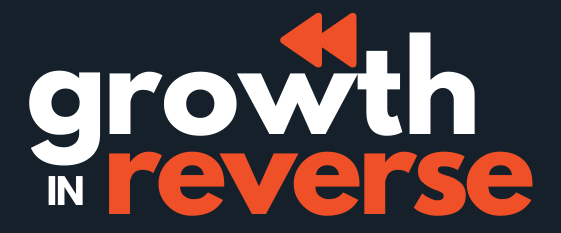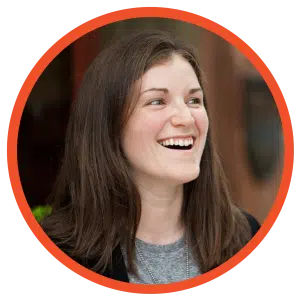Dave Kline went from a decorated management career with Bridgewater to a social media influencer with over 200k followers.
When he started on Twitter in 2021, he went from 40 followers to over 60,000 followers in just 8 months.
And he was able to turn his social media following into a million-dollar creator business in less than 3 years.
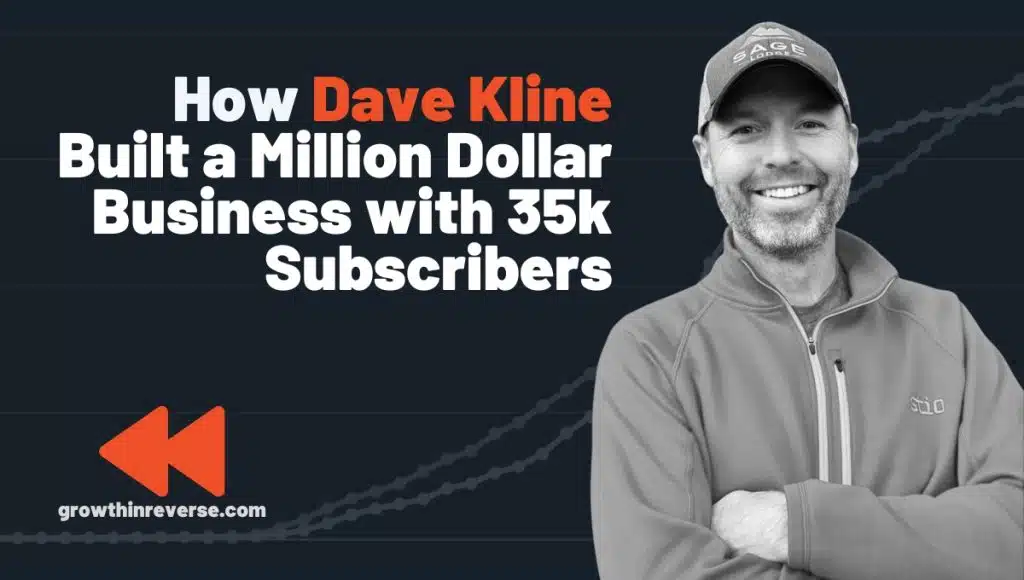
Dave started the MGMT newsletter in 2023, writing about leadership and management fundamentals. Around 18 months later, he has over 35k subscribers.
But, I’m almost positive he cracked the first million dollars before he had 20k subscribers – but I have no solid proof as I can’t see his P&L, so I won’t claim it. 🙂
If you enjoy this post, leave a comment on LinkedIn or Twitter. I’d love to hear your thoughts.
A Little Backstory
If you didn’t recognize the name from above, the company Dave worked for, Bridgewater, is Ray Dalio’s firm and known for radical transparency.
I mention this because the company is set up in a way that you are getting constant feedback. Dave estimates he received over 10,000 pieces of public feedback in his time there.
How does he know? Each team member had an iPad and would give you ratings throughout the day, even in the middle of presentations.

Feeling like Dave did not prepare well for this meeting? Give him instant feedback. And not just something for him to see later, no, this was real-time.
Can you imagine having that low score pop up on the screen while you’re trying to present something? Oof.
Having experience with management and leadership in a company setup like that gives him a huge leg up in terms of experience and skill to be able to teach others proper leadership fundamentals.
But he didn’t leave his job expecting to start teaching these skills.
From Management to Online Business
He and his wife, Mar, bought SkillScouter.com and were planning on growing that business into a huge online review site for digital courses.
But their traffic came mostly from Google and other search engines, which can be unstable, so they knew they needed to diversify a bit and looked toward social media.
Dave enrolled in Sahil Bloom’s audience-building course to learn the ins and outs of Twitter growth.
In the beginning, he was writing online about education and online courses.
He wasn’t planning on creating an online course himself, but after writing online every day on Twitter, he started to see patterns emerge. People were much more interested in his content around management and leadership, so he started posting more about those instead of education.
Dave and his wife, Mar (short for Marsden), realized this and decided they could put together a course to teach in-house at larger organizations helping their new managers improve their skills.
Then he met the founders of Maven, Wes Kao and Gagan Biyani. They convinced him to create a course on their platform instead of a “traditional” course.
Dave and Mar decided that they would try it out – hoping this digital course would get 5-10 students and subsidize the cost of building out a full in-person curriculum.
Dave posted this tweet to announce they were building the course:
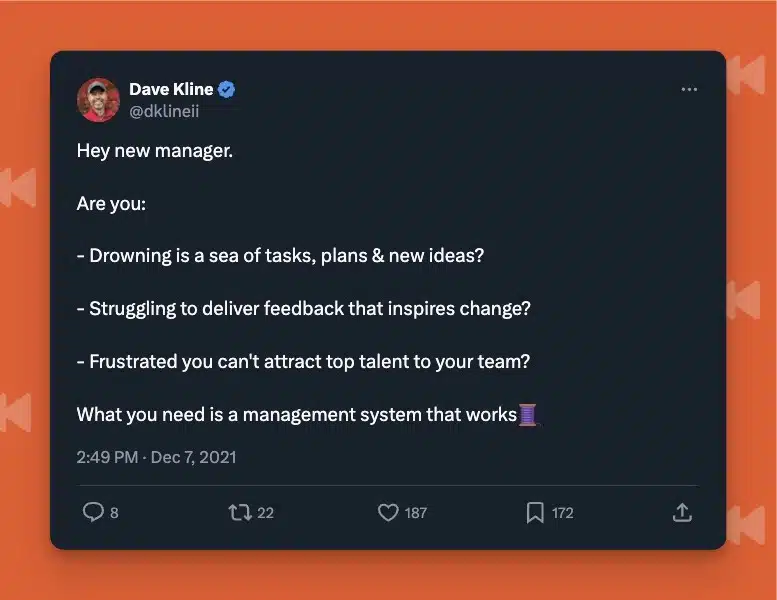
Side note: I will be mentioning Dave’s name quite a bit as he is the face of this brand. But don’t forget that his wife is a huge piece of the pie when it comes to the business.
How the Business Makes Money
In terms of monetization, this is a pretty straightforward business.
It’s all about management and helping leaders become better versions of themselves. There are no side businesses or holding companies that I can tell, just a pure focus on helping others become better managers.
Cohort-Based Courses
The main pillar of this business is a cohort-based course on Maven called the Management Accelerator.
At this point, they charge $2,500 for the full 4-week course. Their first cohort was $750, and then they jumped the price up to $2,000 after a few cohorts.
They have also been experimenting with a more condensed version of the course called Management Fundamentals, which is $950 for a 2-day sprint.
Since launching the course on Maven in 2022, Dave and Mar have helped over 1,000 students.

Let’s do some math. Since there are typically discounts involved and Maven takes a cut, I’ll use an average course cost of $2k.
1,000 students at $2,000 = $2,000,000 in course sales
That might be a little high, but even if we shave off 25%, that’s still $1.5 million in sales.
That’s WILD. So well deserved. And the best part is that’s only one of their revenue streams.
Customized Leadership Programs
I believe this is essentially their Maven course curriculum but taught in-house for a specific company.
Because they are teaching multiple managers at once and customizing this for a specific company, I’d imagine the revenue from these is much higher than the “digital” version.
Are these “students” included in the 1000 from above? I’m not sure, so I’m going to guess these are included in the number above.
1:1 Executive Coaching
While I couldn’t find the exact cost, I’d imagine Dave charges a pretty penny for 1-1 help like this.
For reference, Dr. Julie Gurner charges around $8k per month for executive coaching. Even if he’s charging half of that, it’s a decent revenue stream.

He mentioned here that he works with 5 clients at a time, which would be $20k per month if he charged $4k.
As a conservative estimate, that’s $240k per year from coaching.
Speaking
This feels like something Dave has started leaning into more. Speaking fees can range from $1k to $50k+ so I’m not going to guesstimate on this one.
But just know there is more to the monetization story here 🙂
All in, I’d estimate he’s made around $2 million from this business since launching in 2021.
The awesome part of the monetization piece is that while Dave now has 35k subscribers, up until March of this year he had 20k. But he was still able to bring in 7-figures with this business with that “small” email list.
The Growth Timeline
If you look closely, you can see that Dave came out of the gates swinging with his Twitter growth.
In the 8-9 months between November 2021 and August 2022, he grew from 40 followers to 66,000.
Whoa.
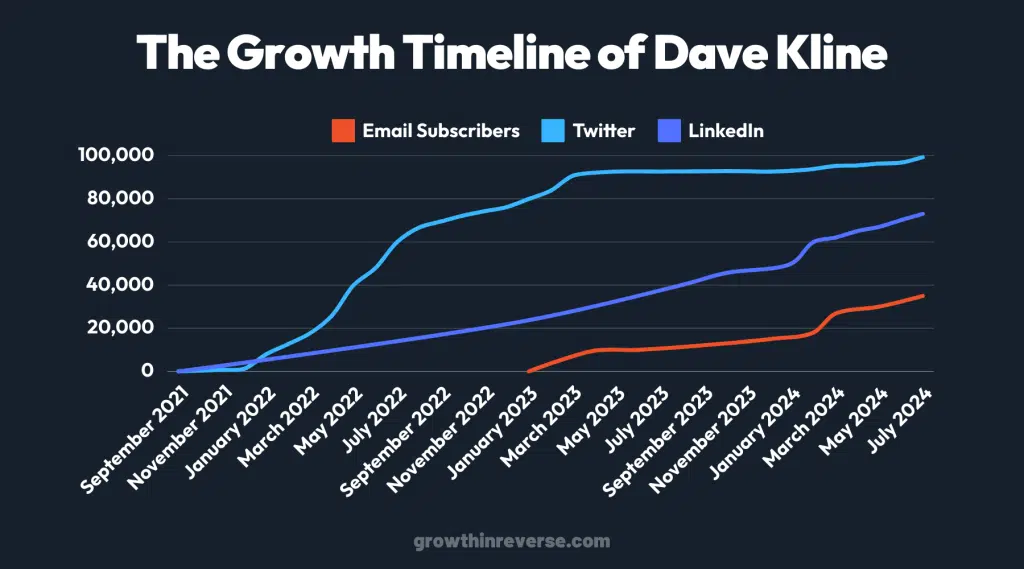
It slowed a bit after that but was still consistently growing. His growth kind of stagnated after February 2023.
Was it because that’s when Elon started making a bunch of changes, or did Dave decide he wanted to focus on LinkedIn and his newsletter?
Maybe it’s a combo of things 🙂 But lately, his Twitter growth has started to ramp back up and he just hit 100k followers there, which has been fun to watch.
But LinkedIn has been where the consistent, sustainable growth has happened lately. We’ll get into that more in a bit.
The Growth Levers
So how have Dave and Mar been able to build a million-dollar business with just 20-30k email subscribers? Let’s dive into it.
👩🏫 1. Don’t Just Tell, Show. There’s a lot of information out there on the internet, but Dave can cut through the noise with this strategy.
🐦 2. Building on social. Social media has been a huge part of Dave’s growth. He had a combined following of 100k before he even started his newsletter.
📬 3. Turning followers into subscribers. Growing on social is great, but how do you get people to become email subscribers? There are a few ways Dave does this.
🫶 4. Find your tribe. Being a creator is lonely. When you can find other people to grow alongside, it’s a much better experience and can help you grow faster.
🎓 5. The Million Dollar course. The accidental course Dave created has turned into a 7-figure revenue stream.
1. Don’t Just Tell, Show 👩🏫
The way Dave lays out his content is subtly different from a lot of other folks. But it’s in that subtlety that the gold lies.
Instead of sharing stories and telling people how to become better leaders, he gives concrete examples.
This shows up in his writing and within the lessons of the course.
He is consistently sharing:
- The What
- The Why
- The How
Alongside real-life examples most of the time.
Within The Course
A really interesting example of this is the concept of getting feedback. As a leader, getting feedback from your team is critical.
But how can you expect your team to give feedback when you aren’t giving them some as well? Dave implements a real-world example of this in the second module of MGMT Accelerator.
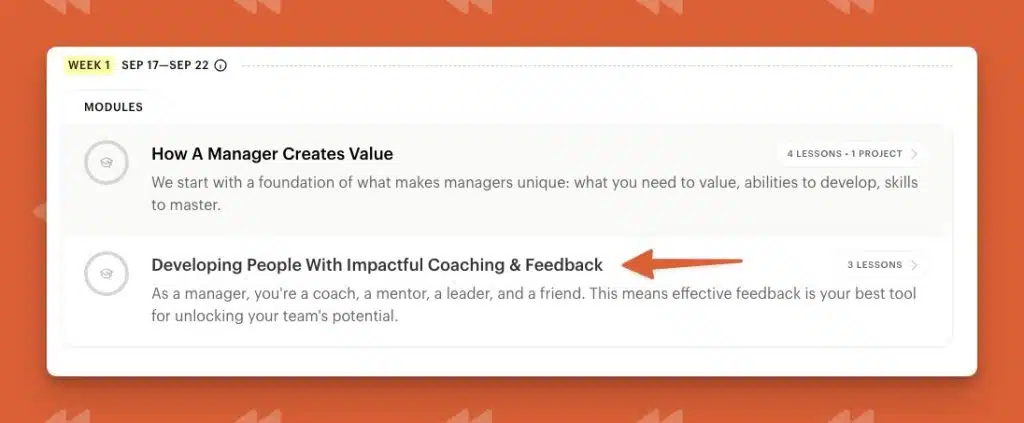
They talk about this concept in-depth, but they don’t just tell them why this is important and how to do it.
They also layer in a real-world example. He gets his students to exercise this “feedback” muscle by asking them for feedback on the course so far.
By seeing how others give feedback, they are learning best practices while being able to test this out for themselves.
And by doing this in a “safe place”, they’re able to make low-risk mistakes and learn from them in real time.
Not to mention, Dave and Mar get feedback from their students early on in the course so they can manage expectations and make changes as they go….all while collecting testimonials from students 🙂
The Newsletter
He does this in the newsletter as well. It’s what makes people keep coming back.
He breaks each edition of the newsletter into a few parts.
First, he introduces the “what” and addresses the “desired outcome” or the “why” behind this whole idea.
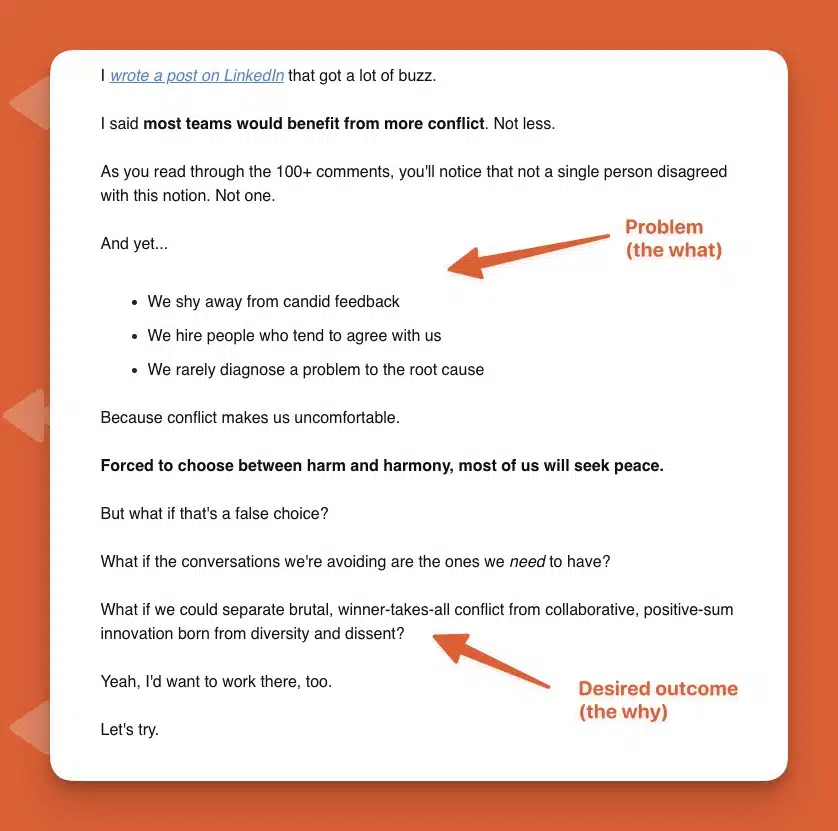
He then moves into the “how” or the big idea of how we can solve this:
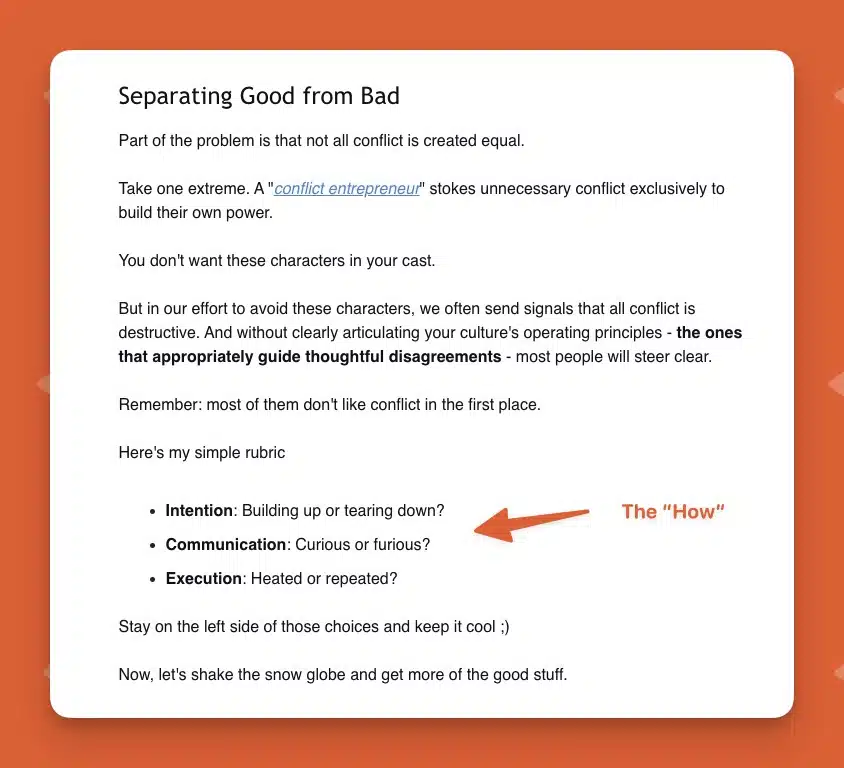
He then goes into detailed ways you can implement this “how” with tactical ideas and real-world scenarios.
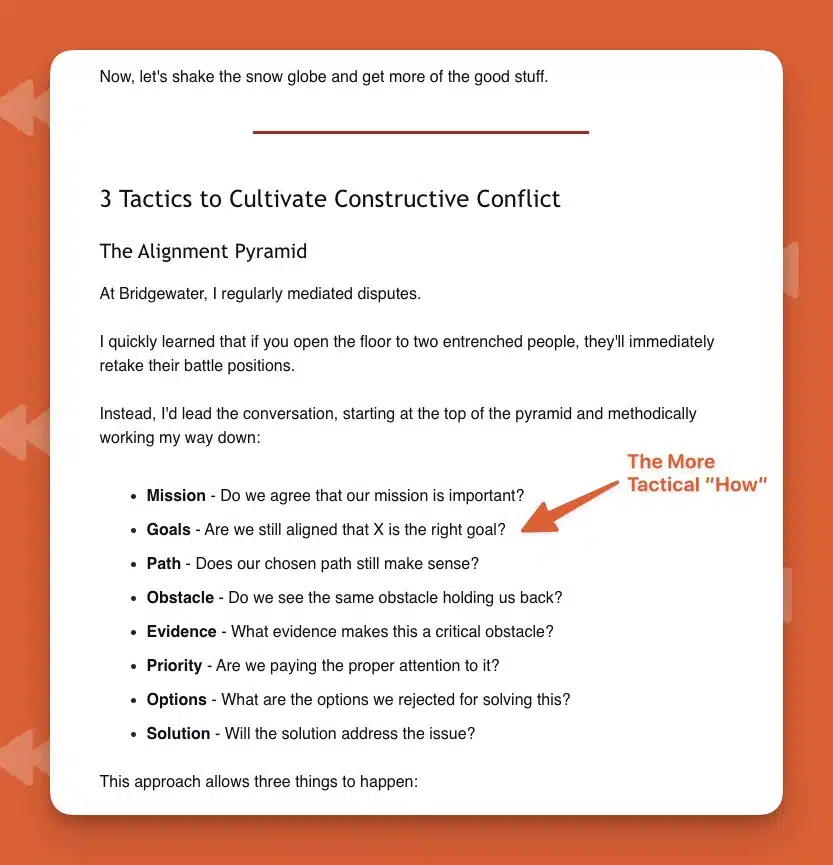
Dave calls the newsletter the MGMT Playbook, and for good reason. These are clear, concrete steps you can take to actually implement this “play.”
One of the keys to success with a newsletter is having extraordinary content. And this is an example of that.
Where else can you find tactical ways to improve your management skills from people who have decades of combined management experience from world-renowned companies?
Not many places. That’s the point. It’s extremely valuable, super tactical, and can earn you more money. Oh, and it’s free.
If you want to read that full article, you can do so here (it’s a good one).
2. Building on Social 🐦
It would be silly to not include social media in Dave’s journey. After all, he built a pretty large business off of his social following before he even started his newsletter in 2023.
Dave’s entire creator journey started on Twitter, where he just crossed 100k followers.
Since then, he’s expanded to LinkedIn as well, with over 73,000 followers on that platform, but it all started with Twitter.
The Course That Got Him Started
In 2021, Dave took a course from Sahil Bloom about audience building.
You might remember hearing about this course in past deep dives because it was the same one that people like Nathan Baugh, Zain Kahn, Brian Bourque, and Amanda Natividad all took together.
While that course produced a bunch of social media rockstars, sadly, it no longer exists today.
But the skills Dave learned in that course were invaluable.
Keep in mind that Dave went into this thinking he would write about education and online courses.
And some of those posts did pretty well:
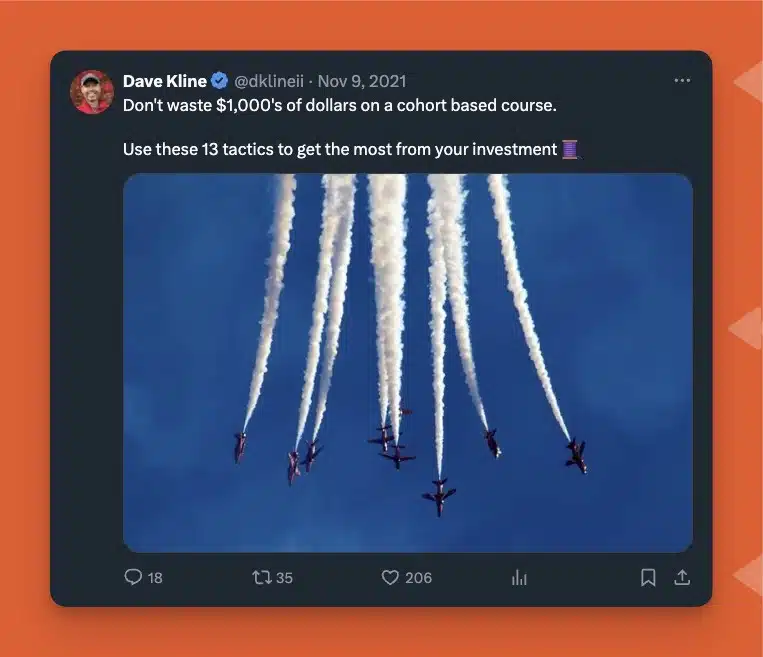
But after going through the process of writing online consistently, he realized that the topics people enjoyed reading from him were about Management and Leadership.
So he doubled down on those topics instead of trying to make the online education stuff work.
That’s when his social accounts took off and started growing much more rapidly.
Within a matter of months, Dave had gone from 40 followers to 60,000.
Here is one of the first threads he wrote that went pretty viral:
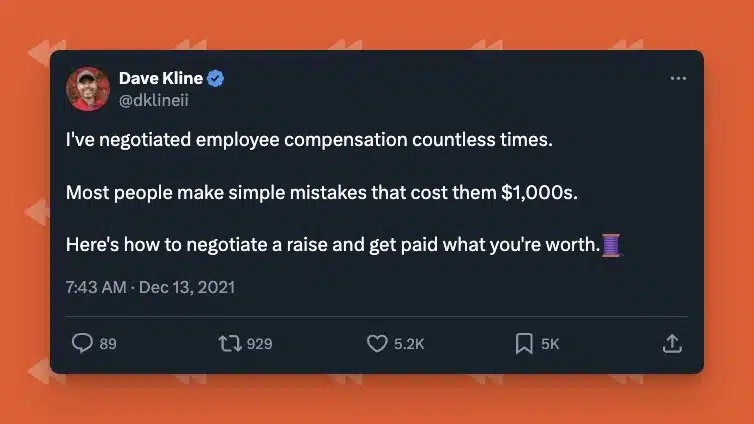
Note from the previous tweet, these were only a month apart.
It shows the power of sticking with this and working through your ideas until you hit on something that you enjoy writing and the audience loves reading.
Repurpose Your Best Work
It’s easy to get stuck in the trap of create, create, create.
But once in a while, you need to step back and re-share some of your best work.
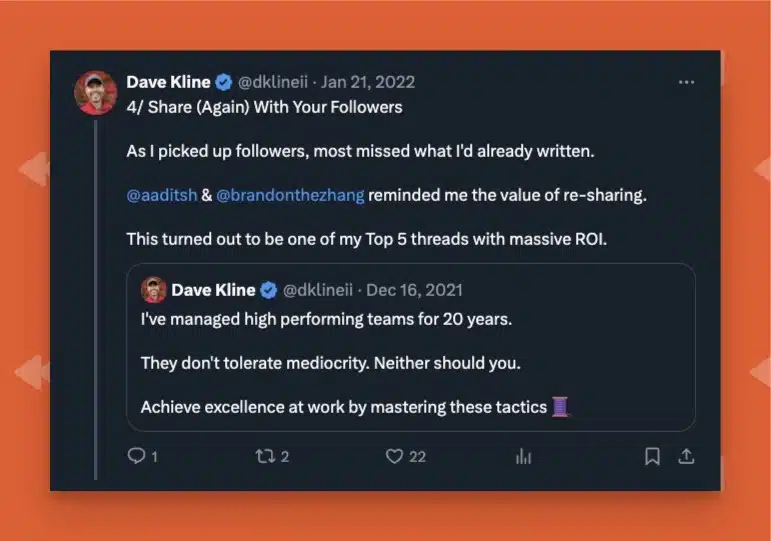
That thread is about high-performing teams, but if you look closer, it’s actually a thread of his past threads.
He’s just curating them in a way that is more cohesive for the reader.
He’s already shared these tidbits of advice before, so why not reshare them and showcase this content to his newer followers?

Not every post will work out, but sometimes you hit a home run.
The Big Hits
You can see in the comment below that Dave mentions how it’s a few viral posts that drove the bulk of the signups from social:

But you can’t exactly get to that place without trying again and again to learn the platform and improve your writing.
3. Turning Social Followers into Subscribers 📬
Dave was able to figure out what was working on Twitter and LinkedIn, but those people don’t just magically translate into email subscribers.
Here are some of the ways he’s able to turn viewers into subscribers.
The Post-Engagement Teaser
The first is what we can call a “post-engagement teaser” post. Yes, that’s a mouthful, let me explain.
Dave shares a tweet about management, that may or may not be directly related to the topic of his newsletter that week.
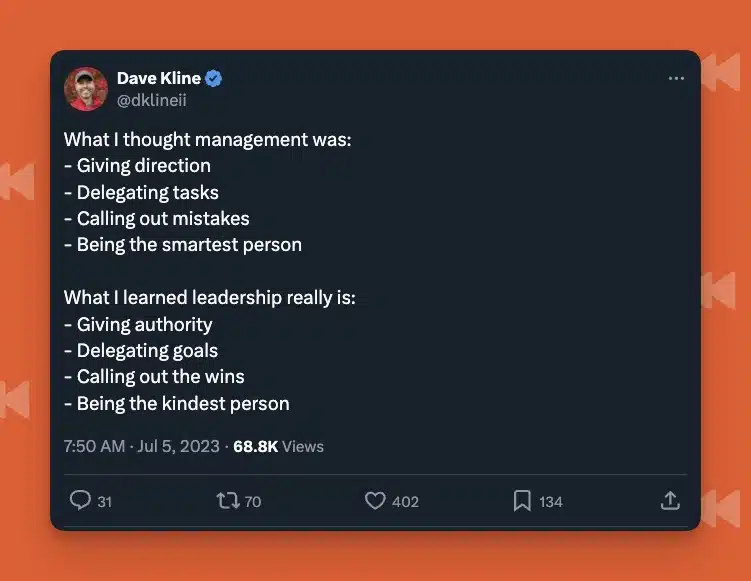
Then a few hours later, after it hits a certain number of engagements, he posts a call to action (CTA) to join his newsletter:
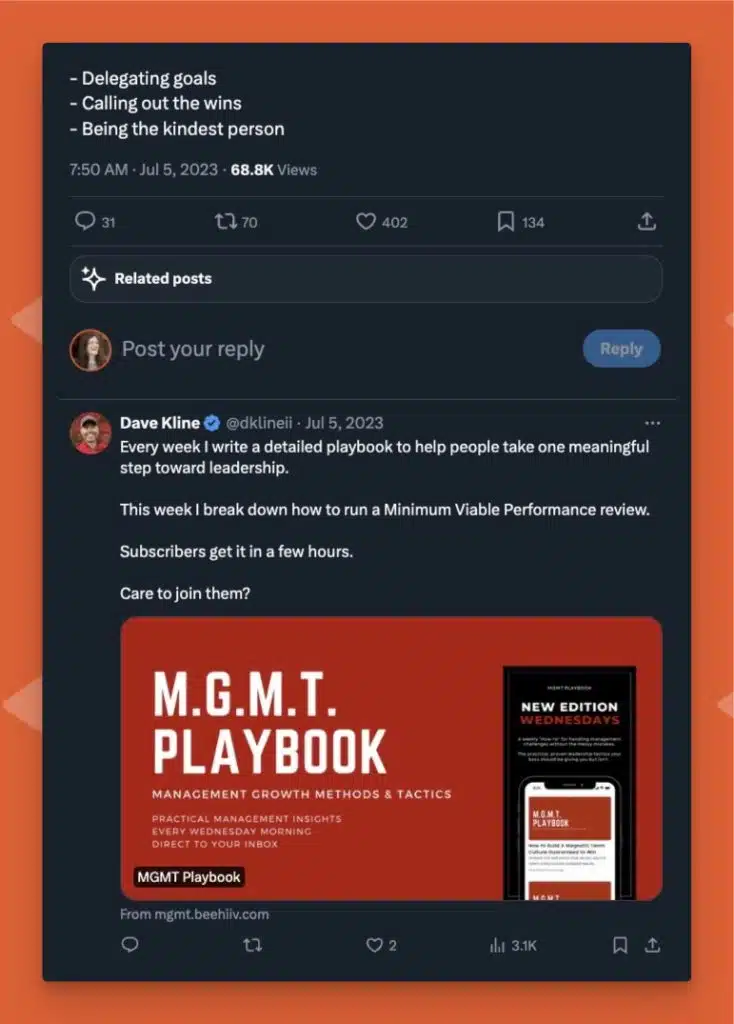
This isn’t a comment, it’s an additional tweet on the original post, almost creating a mini-thread.
But this isn’t just a typical “if you like this, you’ll like my newsletter” type of post. He customized it to talk about that upcoming issue and what the topic was.
I like this method because it stands out more than the bland newsletter callout.
Of course, I’d bet that if he more cohesively tied together the original tweet with the callout, it may have performed better.
But honestly, it’s not easy getting every piece right, and there is something to be said about just doin’ the damn thing.
Dave is a LinkedIn Top Voice, which has its benefits, but kind of hinders your ability to promote your work and drive people off the platform.
From what I’ve heard, the LinkedIn team doesn’t exactly love it when you link people out to your newsletter or website. So as a “Top Voice,” I think it’s looked down on to do that with every post.
You can still do it, but I think there’s a good balance to it.
Here is a recent example where Dave included a link to his newsletter at the end of his post:
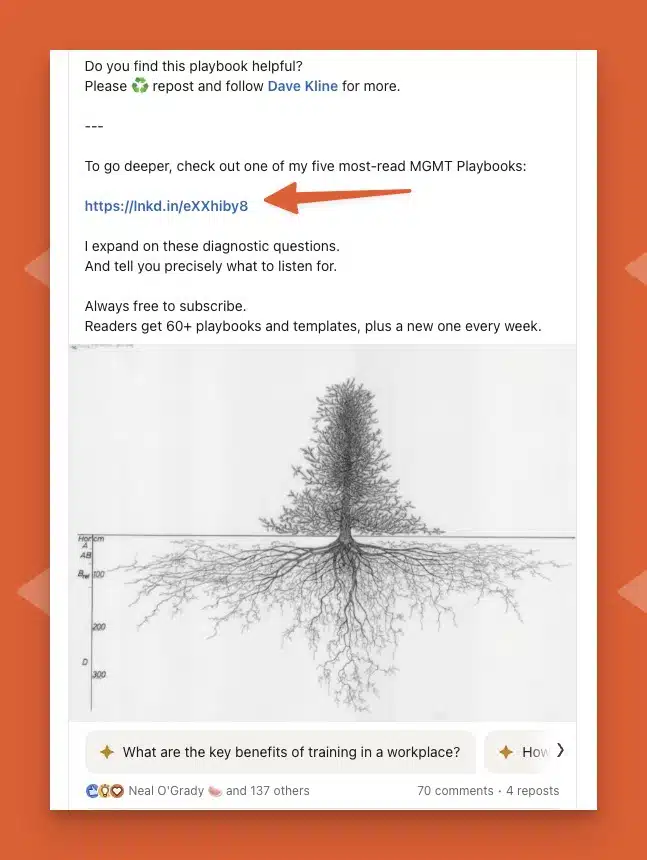
That’s one way he is able to drive people back to his newsletter. But you can also have a CTA in your bio, which is a good way to get people over to your site.

You also get that shiny blue LinkedIn badge next to your name, so that’s fun and I’m sure it adds credibility.
4. Find Your Tribe 🫶
I feel like I’m beating a dead horse every time I write a deep dive, but building relationships is arguably the most important piece of the growth puzzle.
And here it is again, Dave is another example of building strong relationships to grow your audience.
From his experience of being surrounded by people day in and day out during his “regular” career, I have to imagine this gave him a huge leg up when he transitioned into the creator space.
He knows the benefits of not building alone.
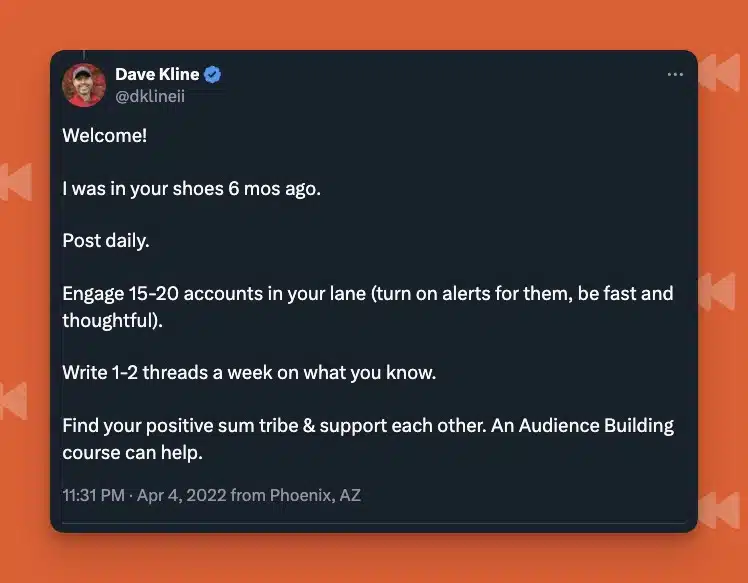
In one of his posts, he gives a few reasons he thinks building relationships is important:
- The Journey is Long & Lonely. There’s no void to scream into if few friendly faces are always hanging around. Travel in packs.
- Social Proof is Powerful. Have you bought many things off Amazon with zero reviews? Me neither. Your crew’s engagement will help legitimize your work.
- Harness Positive Sum Dynamics. Strong brands have a halo effect. This is true with personal brands. As you help them grow their brand, yours grows with it. Once you see the cycle of “You-Win-I-Win-We-Win,” you can’t unsee.
I wanted to share those in his own words because I know it can get boring hearing me say the same thing again and again 🙂
Alright so let’s dig into some of the people he’s surrounded himself with.
Sahil Bloom
Remember how I told you he took Sahil’s audience-building course? That’s an instant connection to the instructor and the other students.
He was able to get feedback and see exactly how a top creator was thinking about their content strategy and Twitter growth.
Maker’s Mark
Brandon and Aadit are two guys who ran a similar type of course on Maven called Maker’s Mark.
Dave took this course to get another perspective on this growth stuff.
The Maven Team
Both of these courses lived on the Maven platform, which was in it’s early days. This also gave Dave a little more “in” with the creators of Maven and he could see what they were building.
That helped him with the decision to host his courses on Maven as well, more on that below.
Austin Belcak
Dave knew that Austin Belcak, who had been wildly successful on LinkedIn was moving over to Twitter but wasn’t sure how to best go about it.
Dave was trying to do the opposite (move over to LinkedIn), so he figured he could help Austin make the move. By doing so, he was able to get some feedback on making the switch to LinkedIn.
The platforms are similar, but also pretty different, so having a friendly face and some pointers can be a big help.
How to Find Your Tribe
One of the ways Dave has found his tribe and recommends is to pay for a course or community.

Free groups can work, but oftentimes people fizzle out.
When you put up some money, you’re filtering out people who aren’t serious and in this for the long run.
5. The Million Dollar Course 🎓
The most fascinating part of this journey is how Dave has been able to take his social following and create a very healthy business out of it.
It all started on December 7, 2021, when Dave tweeted about the launch of the course.

He opened up the waitlist, hoping to get around 10 students to subsidize the creation of the in-person curriculum as he was planning on teaching these ideas to larger organizations.
What he didn’t realize is that 10 people would turn into a waitlist of 150 people who wanted to take his course.
He woke up the next day pretty surprised to see that many people were interested.
They launched the “New Manager Accelerator” to 35 students at $750.
Learn From Your Customers
One of the truly surprising findings was that while they created this with a brand new manager in mind, they were getting applications from people who had 3-5+ years of experience as a manager.
They hopped on calls with all of these people after telling them they couldn’t join because it wasn’t for them.
But they quickly realized that so many people were thrown into the fire without proper training, and they had nowhere to go. The concepts they were teaching were things they were still figuring out on their own and wanted to learn the “right” ways to do them.
That was a huge learning for them, and probably why they dropped the “New” piece of the “New Management Accelerator.”
In every cohort, they ask for feedback to learn how to improve the course. They have taken this feedback and implemented it in many ways, helping them improve the student experience.
Course Structure
They even experiment with different structures of the course to better help their students.
In February 2023, they asked newsletter readers if they would consider taking MGMT Accelerator if they shortened it and ran it at night.
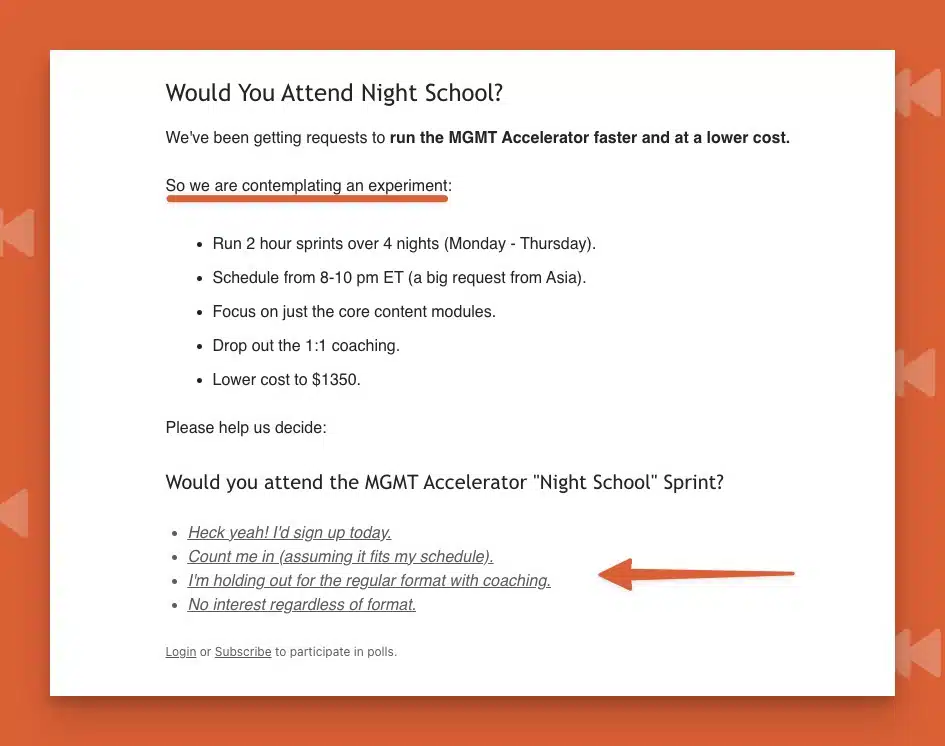
I don’t believe they moved forward with it so they must not have gotten enough signal that people really wanted this.
They’ve also started doing weekend editions of the course:

This one is more geared towards actual new managers and is run over the course of a few days instead of multiple weeks.
One of the biggest changes they made came about by surveying people who wanted to take the course.
They asked them what they were struggling with when it came to management, and so many said they needed help with delegation. This topic wasn’t even on their radar in the beginning because as a manager, your main job is delegation.
Dave said that one module around delegation is like the “engine” of the course. It’s the thing that gets most people to join, and then they teach them all of the other things they didn’t realize they needed help with as well.
By experimenting and getting feedback from students, they’ve been able to make the course even better over time.
That leads to better reviews and ratings, which leads to more students.
It’s almost like a “feedback flywheel” they are building.
How You Can Replicate His Success
Dave’s growth has been all about consistency, focus, and serving his niche. But there are a few specific I think we can learn from.
Focus on One Platform
This is one I’ve seen time and time again. Creators get very good at one platform before moving on to others.
Dave was no different.
He grew his audience on Twitter to 60k in 8 months by writing daily. The daily cadence helped him speed up his learning because he was getting constant feedback about what people wanted to read and what they didn’t.
Find Your Tribe
Relationships have been a pillar of Dave’s success – and learning from others on the same journey can be extremely beneficial.
Remember how I said focusing on one platform lets you get feedback daily? When you’re part of a group of people growing together, you end up going from only having data around your posts, to benefiting from the learnings of 5-10 of your friends who are all on a similar path.
Can you imagine how much faster you’ll learn new skills and what’s working when you can share those insights with each other?
Don’t Just Tell, Show Them How
There is so much information out there about the what and why – but not enough about the implementation.
You don’t have to give away every single thing (although it’s probably beneficial to do so), but how can you give people just a little bit more than they get from others?
This tweet from Dave says it all:
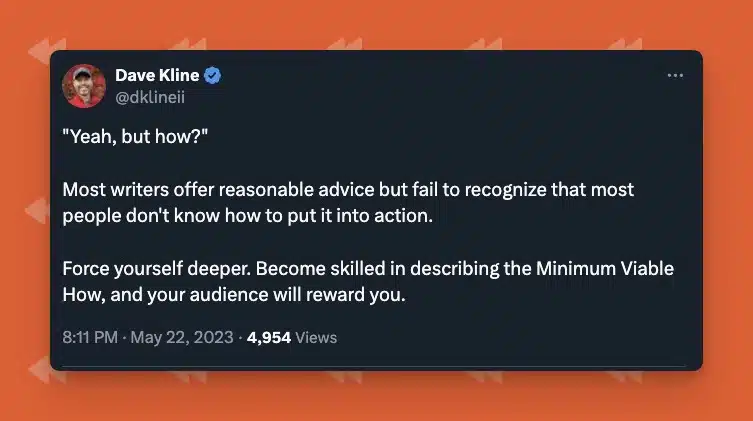
Force yourself to go deeper and get better at providing the details and the “Minimum Viable How.” People will start to see real results from your ideas and then associate you with their success in that area.
Instead of sharing high-level ideas like everyone else, how can you take it a few steps further and truly help someone?
